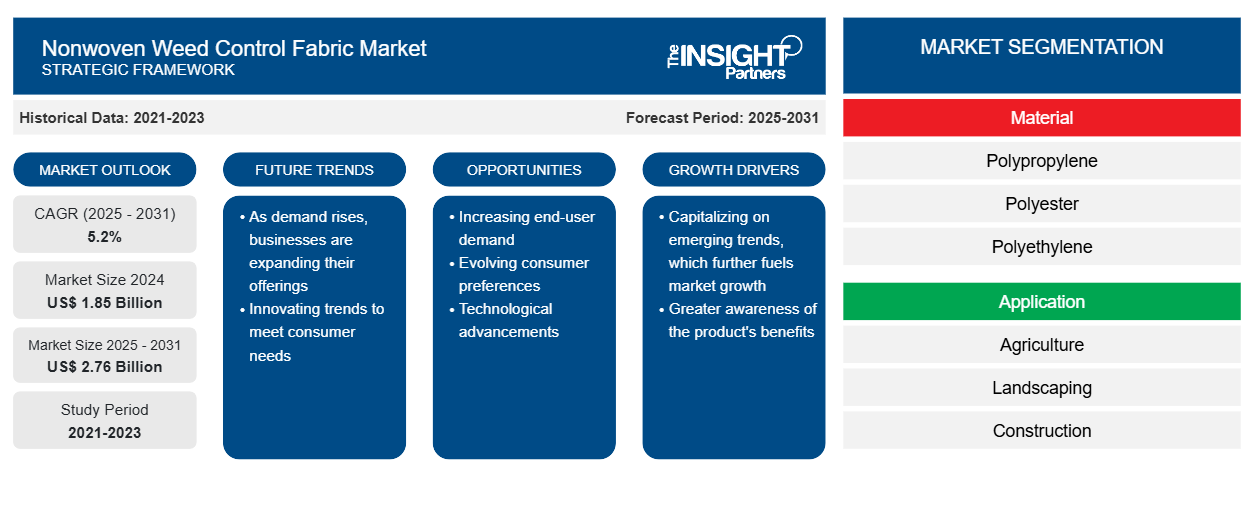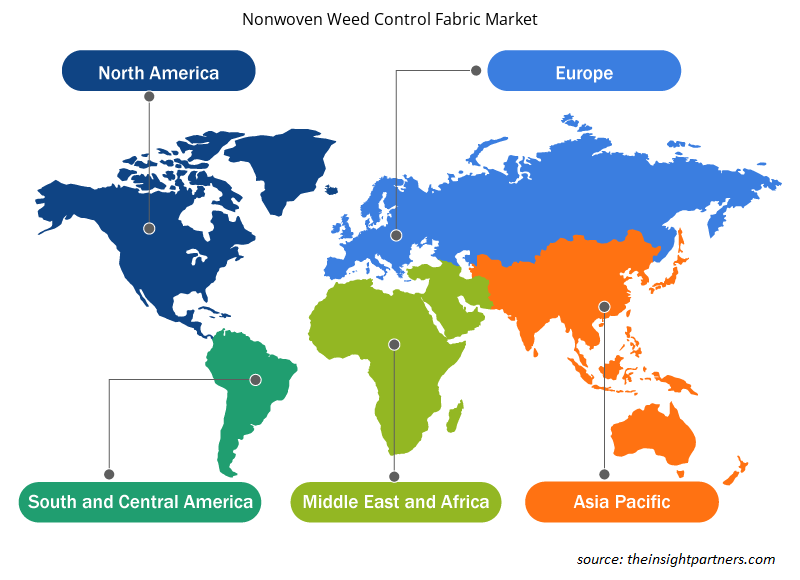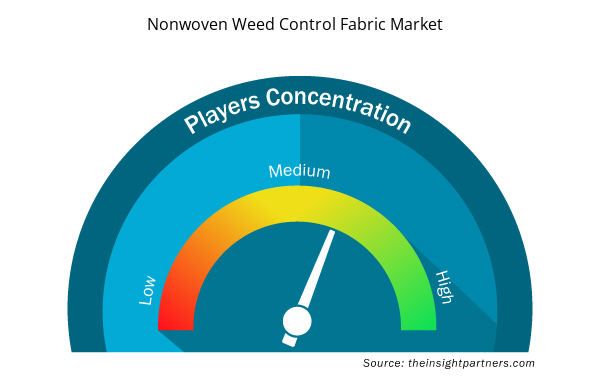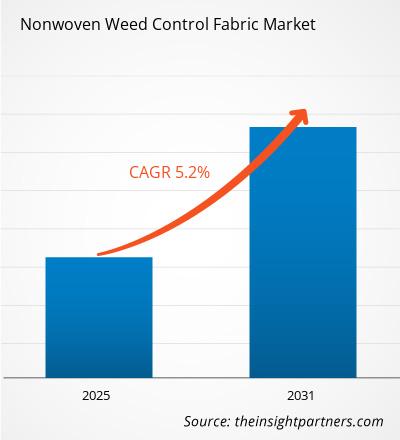The nonwoven weed control fabric market size is projected to reach US$ 2.76 billion by 2031 from US$ 1.76 billion in 2023. The market is expected to register a CAGR of 5.2% in 2023–2031. The growing demand from application sectors, including agriculture and landscaping, is likely to remain a key nonwoven weed control fabric market trends.
Nonwoven Weed Control Fabric Market Analysis
The primary purpose of nonwoven weed control fabric is to suppress weed growth by blocking sunlight and providing a physical barrier to prevent weed seeds from germinating. This fabric effectively prevents weeds from sprouting and competing with desirable plants for nutrients and water. It also helps conserve soil moisture by reducing evaporation, which can be especially beneficial in arid or drought-prone regions. These leads to the nonwoven weed control fabric market growth. In addition, these fabrics are typically permeable to air and water, allowing for proper aeration and drainage, which is crucial for the health of the plants it is used with. Furthermore, it is easy to install. It can be laid out over the soil surface and secured with anchors or mulch. This minimizes the need for chemical herbicides and reduces the labor required for ongoing weeding and maintenance. Additionally, it contributes to a neater and more organized appearance in garden beds and landscaped areas. These factors are expected to drive the nonwoven weed control fabric market growth.
Nonwoven Weed Control Fabric Market Overview
Nonwoven weed control fabric is breathable, allowing air and water to pass through, ensuring proper soil aeration and moisture retention. This fabric is highly durable and designed to withstand exposure to the elements, making it suitable for long-term use. It is easy to install, reducing the need for ongoing weeding and maintenance efforts, and is used in a variety of settings, from home gardens to large-scale agricultural fields and commercial landscaping projects. It aligns with the growing emphasis on sustainable and environmentally responsible gardening practices, providing an effective solution for maintaining weed-free and well-kept outdoor spaces. As urbanization continues to rise, landscaping projects and the development of residential and commercial properties have expanded. This surge in construction and landscaping has increased the demand for effective and low-maintenance solutions to control weeds while maintaining the aesthetics of green spaces. Nonwoven weed control fabric has proven reliable and efficient in these settings, further contributing to its growing demand. Furthermore, the agriculture sector is another major driver of demand for nonwoven weed control fabric.
Customize This Report To Suit Your Requirement
You will get customization on any report - free of charge - including parts of this report, or country-level analysis, Excel Data pack, as well as avail great offers and discounts for start-ups & universities
Nonwoven Weed Control Fabric Market: Strategic Insights

- Get Top Key Market Trends of this report.This FREE sample will include data analysis, ranging from market trends to estimates and forecasts.
You will get customization on any report - free of charge - including parts of this report, or country-level analysis, Excel Data pack, as well as avail great offers and discounts for start-ups & universities
Nonwoven Weed Control Fabric Market: Strategic Insights

- Get Top Key Market Trends of this report.This FREE sample will include data analysis, ranging from market trends to estimates and forecasts.
Nonwoven Weed Control Fabric Market Drivers and Opportunities
Surging Demand for Agriculture Industry Bolsters Nonwoven Weed Control Fabric Market Growth
Farmers and growers seek methods to enhance crop yields while minimizing the competition from weeds. This fabric helps create a weed-free environment around crops, reducing the need for manual weeding and herbicides, thus improving agricultural productivity and efficiency. Furthermore, the global trend towards reducing water consumption and conserving natural resources has contributed to the nonwoven weed control fabric market growth. By reducing the growth of weeds and minimizing water evaporation, this fabric aligns with water-saving initiatives, making it an attractive choice for regions where water conservation is a priority. Further, countries such as China boast a vast agricultural sector, and nonwoven weed control fabric has become increasingly popular among Chinese farmers. This factor is driving the market growth.
Increasing Adoption of Sustainable Agriculture in Developing Economies
The increasing awareness of sustainable and eco-friendly gardening and landscaping practices has led to a growing demand for weed control solutions that reduce the reliance on chemical herbicides. Nonwoven weed control fabric offers an environmentally friendly alternative by preventing weed growth without the need for harmful chemicals, making it particularly attractive to eco-conscious consumers. Additionally, the rise in urbanization and landscaping projects has boosted the demand for weed control solutions. As more people engage in gardening and landscaping activities, the need for efficient and time-saving methods to control weeds becomes paramount. Nonwoven weed control fabric simplifies weed management, reduces maintenance efforts, and enhances the appearance of landscaped areas, making it a preferred choice for residential and commercial landscaping projects. These factors are expected to drive the nonwoven weed control fabric market growth.
Nonwoven Weed Control Fabric Market Report Segmentation Analysis
Key segments that contributed to the derivation of the nonwoven weed control fabric market analysis are material and application.
- Based on the material, the market is bifurcated into polypropylene, polyester, polyethylene, and others. The polypropylene segment held a larger market share in 2023.
- In terms of application, the market is segmented into, agriculture, landscaping, construction, and others. The agriculture segment held the largest share of the market in 2023.
Nonwoven Weed Control Fabric Market Share Analysis by Geography
The geographic scope of the Nonwoven Weed Control Fabric Market report is mainly divided into five regions: North America, Asia Pacific, Europe, Middle East & Africa, and South & Central America.
Asia Pacific region encompasses a diverse range of countries with varying climates, soil types, and agricultural practices. This diversity creates a strong demand for weed control solutions, and nonwoven weed control fabric has proven adaptable to various agricultural and horticultural applications. India and China are among the world's largest agricultural producers, with vast farmlands and a significant need for effective weed management. Many farmers in these countries embrace nonwoven weed control fabric as a cost-effective and efficient way to control weeds, improve crop yields, and conserve soil moisture. Additionally, Asia Pacific region has seen rapid urbanization and landscaping projects. As more urban areas and green spaces are developed, there is a growing need for solutions that maintain the aesthetics of landscapes while controlling weed growth. Nonwoven fabric market for weed control has found applications in both residential and commercial landscaping projects, contributing to the nonwoven weed control fabric market share.
Nonwoven Weed Control Fabric Market Regional Insights
The regional trends and factors influencing the Nonwoven Weed Control Fabric Market throughout the forecast period have been thoroughly explained by the analysts at Insight Partners. This section also discusses Nonwoven Weed Control Fabric Market segments and geography across North America, Europe, Asia Pacific, Middle East and Africa, and South and Central America.

- Get the Regional Specific Data for Nonwoven Weed Control Fabric Market
Nonwoven Weed Control Fabric Market Report Scope
| Report Attribute | Details |
|---|---|
| Market size in 2024 | US$ 1.85 Billion |
| Market Size by 2031 | US$ 2.76 Billion |
| Global CAGR (2025 - 2031) | 5.2% |
| Historical Data | 2021-2023 |
| Forecast period | 2025-2031 |
| Segments Covered |
By Material
|
| Regions and Countries Covered | North America
|
| Market leaders and key company profiles |
Nonwoven Weed Control Fabric Market Players Density: Understanding Its Impact on Business Dynamics
The Nonwoven Weed Control Fabric Market is growing rapidly, driven by increasing end-user demand due to factors such as evolving consumer preferences, technological advancements, and greater awareness of the product's benefits. As demand rises, businesses are expanding their offerings, innovating to meet consumer needs, and capitalizing on emerging trends, which further fuels market growth.
Market players density refers to the distribution of firms or companies operating within a particular market or industry. It indicates how many competitors (market players) are present in a given market space relative to its size or total market value.
Major Companies operating in the Nonwoven Weed Control Fabric Market are:
- Glatfelter Corporation
- Foshan Rayson Non Woven Co.,LTD
- Thinh Gia Huy L.A Co., Ltd
- DuPont de Nemours, Inc.
- Huizhou Jinhaocheng Nonwoven Fabric O., Ltd.
- Qingdao Yihe Nonwovens Co., Ltd.
Disclaimer: The companies listed above are not ranked in any particular order.

- Get the Nonwoven Weed Control Fabric Market top key players overview
Nonwoven Weed Control Fabric Market News and Recent Developments
The nonwoven weed control fabric market is evaluated by gathering qualitative and quantitative data post primary and secondary research, which includes important corporate publications, association data, and databases. The following is a list of developments in the market for nonwoven weed control fabric and strategies:
- Berry Global Group, Inc. (NYSE:BERY) and Glatfelter Corporation (NYSE:GLT) announced today they have entered into definitive agreements for Berry to spin-off and merge the majority of its Health, Hygiene and Specialties segment to include its Global Nonwovens and Films business ("HHNF") with Glatfelter, to create a leading, publicly-traded company in the specialty materials industry. The Boards of Directors of Berry and Glatfelter have unanimously approved the transaction. (Source: Berry Global Group, Inc, Press Release, 2024)
Nonwoven Weed Control Fabric Market Report Coverage and Deliverables
The "Nonwoven Weed Control Fabric Market Size and Forecast (2021–2031)" report provides a detailed analysis of the market covering below areas:
- Market size and forecast at global, regional, and country levels for all the key market segments covered under the scope
- Market dynamics such as drivers, restraints, and key opportunities
- Key future trends
- Detailed Porter's Five Forces and SWOT analysis
- Global and regional market analysis covering key market trends, major players, regulations, and recent market developments
- Industry landscape and competition analysis covering market concentration, heat map analysis, prominent players, and recent developments
- Detailed company profiles
- Historical Analysis (2 Years), Base Year, Forecast (7 Years) with CAGR
- PEST and SWOT Analysis
- Market Size Value / Volume - Global, Regional, Country
- Industry and Competitive Landscape
- Excel Dataset


- Mice Model Market
- Point of Care Diagnostics Market
- Real-Time Location Systems Market
- Sleep Apnea Diagnostics Market
- Saudi Arabia Drywall Panels Market
- Compounding Pharmacies Market
- Print Management Software Market
- Hair Extensions Market
- Enzymatic DNA Synthesis Market
- Small Molecule Drug Discovery Market

Report Coverage
Revenue forecast, Company Analysis, Industry landscape, Growth factors, and Trends

Segment Covered
This text is related
to segments covered.

Regional Scope
North America, Europe, Asia Pacific, Middle East & Africa, South & Central America

Country Scope
This text is related
to country scope.

 Get Free Sample For
Get Free Sample For